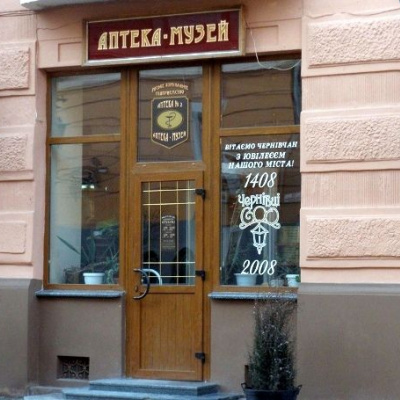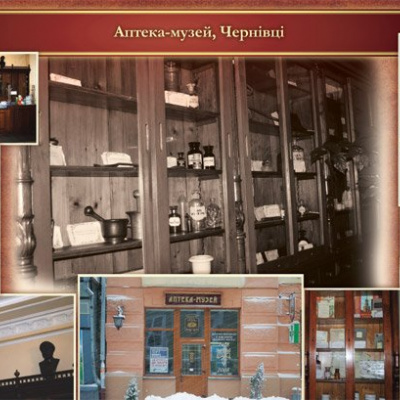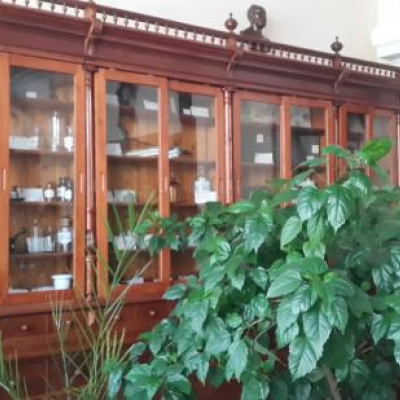Pharmacy-museum, Chernivtsi
Not many cities in Ukraine can boast of pharmacy museums. Apart from the most famous ones in Lviv and Kyiv, the average tourist is unlikely to name any more. However, Chernivtsi has something to present to the city's guests, including a pharmacy-museum on the central O. Kobylianska Street that has been manufacturing and selling medicines for more than a century.
The museum staff managed to fully recreate the interior of the pharmacy from the first half of the 20th century. You will be able to see the original pharmacy furniture from 1903, which is a real value of the museum's collection. In total, there are about 90 exhibits that were used for the manufacture of medicines and their packaging. It will be interesting to see a special frying pan where activated carbon was prepared, scales, pipettes, flasks, cocoa beakers, cocoa crushers - everything necessary for pharmaceutical activities in the early 20th century.
The museum also has a collection of pharmacy literature, including recipes for preparing medicines and books on medicinal plants. The perimeter of the hall is decorated with busts of the fathers of pharmacy - Galen, the ancient Greek god patron of doctors Asklepios, Aristotle and Hippocrates. Today, it is the only pharmacy in Chernivtsi where they still prepare custom-made dosage forms on their own.
The pharmacy was opened in 1903 and is located in a building on O. Kobylianska Street, which was built in 1900. Initially, it belonged to the Shymonovych family, but in the 1930s it became the property of the Grossmans, who owned it until nationalization in 1944. Later, during the Soviet era, it functioned as a municipal pharmacy #2.
The building acquired its current appearance after a reconstruction in 1928. In the early 30s of the last century, it became the property of the Grossman family, and in 1944 the pharmacy was nationalized. In order to preserve the city's architectural monument and restore the history of pharmacy, the Executive Committee of the Chernivtsi City Council adopted a decision of 27.05.2003 No. 372/11 to create a pharmacy museum on the basis of the Pharmacy No. 2. The husband of the former manager, Valentyna Fabianivna Kaverdinska, took up the task: Mykola Ivanovych Kaverdinskyi, a well-known architect in Ukraine, breathed new life into the old pharmacy for free, restoring the old interior of the pharmacy.
In October 2003, the pharmacy-museum was inaugurated on the occasion of the 100th anniversary of the pharmacy and the city's day. The most unique exhibit of the museum is the old pharmacy furniture. When giving this furniture for restoration, pharmacists noted the date of its manufacture - 1903. This well-made and high-quality furniture, which has served the pharmacy for exactly 100 years, is a true work of art and impresses with its originality. The museum has 86 exhibits of pharmacy supplies. Among them, special attention should be paid to a 1902 alcohol meter, a frying pan used to prepare activated carbon in Austrian times, as well as copper and brass mortars, Austrian calipers, corkscrews, scales, flasks, pipettes, a machine for crushing cocoa butter, a machine for making pills from the early twentieth century, and a collection of pharmaceutical literature on the manufacture of dosage forms dating back to 1910.
The interior is decorated with busts of the Roman physician Galen (we owe the appearance of Galenic preparations to him, he introduced the concept of ballast and active substances in the composition of medicines and began to extract active substances from plants using wine, acetic acid, and oils). There are also busts of the god of healing Asklepios (who treated diseases with ointments and medicinal infusions) and his daughter Hygia, who is often depicted with a bowl in her hand, from which she drinks a snake (a symbol of holiness and wisdom, inviolability and purity), the goddess of health, from whose name the science of hygiene got its name. Smaller busts of Aristotle and Hippocrates (the book Hippocratic Collection contains a work on medical ethics called The Oath, which is still a guarantee of a doctor's high values). There are 2 departments in the sales area on the first floor: manual sales and prescription. The hand-selling department has new furniture that accurately reproduces a museum piece of antique furniture. Medicines are sold here both with and without prescriptions. The prescription department accepts prescriptions for the manufacture of medicines individually. Pharmacy No. 2 is the only municipal pharmacy in the city that is engaged in extemporaneous preparation of medicines. The assistant's room, where medicines are prepared, is located on the 2nd floor among other production facilities. Every day, 40-50 patients come to the pharmacy with individual prescriptions for the manufacture of extemporaneous medicines. All the prescriptions are complex, multi-component, and in 2012 alone more than 10,000 of them were processed. The pharmacy prepares medicines for children (in particular, many prescriptions are for powders for children), as well as ointments, emulsions, suspensions, solutions, drops, and mixtures. The pharmacy employs qualified specialists with extensive experience, which they generously share with young professionals and interns. The team at the pharmacy is friendly, like one big family. Now the pharmacy is managed by Tamara Prodan, who took over from V.F. Kaverdinskaya. The team can be proud to work in such a unique pharmacy.
The museum is located at 43 O. Kobylianska Street in the very center of the city on a pedestrian street.
Openinghours ofthe Chernivtsi Pharmacy-Museum: the institution is open to visitors from 8:30 to 20:00 daily, on Sunday - from 9:00 to 17:00.
Chernivtsi is the capital of Bukovyna. It is one of the most beautiful and pleasant Ukrainian cities. There is one of the most beautifulrailway stations in the country, theChurch of St. Paraskeva of Serbia, the Church of the Exaltation of the Cross, the ship house, the City Hall (every day at 12:00 a trumpeter plays the melody of "Marichka" from the tower), the Art Museum, then Kobylianska Street, the German Folk House, the Armenian and Assumption Churches (the oldest stone Ukrainian Greek Catholic Church in Chernivtsi), the Theater Square and the Kobylianska Theater. Kobylianska Theater Square, Jewish People's House, Chernivtsi University (included in the UNESCO World Heritage List), Turkish Square (Chernivtsi has been a part of Turkey, Modova, Romania, Austria-Hungary, the USSR, Rus, and Ukraine), and a large rover,cozy streets and cobblestone streets, the so-called Drunken Church, Nazariy Yaremchuk's house, then another house-ship, two houses with the same number (Olha Kobylianska lived here), the house where Volodymyr Ivasyuk lived, the pink church - the Cathedral of the Holy Spirit.
Chernivtsi sights
- St. Nicholas wooden church (from 1607, restored in 1954);
- stone Church of St. George on the Bitterroot (1767 in the Baroque style);
- wooden Trinity Church in Muggles (one thousand seven hundred and seventy-four), moved in 1874 to Kłokuchka;
- wooden Assumption Church on Kaleczanka (1783);
- City Hall with a two-story, 45-meter-high Empire-style tower (1843-1847, architect A. Mykulych), now the City Council;
- Ukrainian Greek Catholic Church (1825-1830 in the Baroque style);
- Byzantine-style cathedral (1844-1864, architect Roll);
- Church of St. Paraskeva in the pseudo-Romanesque style, completed in 1662 (architect A. Pavlovsky);
- residence of Bukovyna metropolitans - since 1956 one of the buildings of Chernivtsi University);
- Armenian Gregorian Church (1869-1875, architect J. Hlavka);
- Chernivtsi University building (1874-1875);
- Jesuit church in the Neo-Gothic style (1893-1894);
- Railway station (1898-1903) in the Art Nouveau style;
- the City Theater (1904-1905, architects F. Fellner and G. Helmer) in the Viennese Baroque style with Art Nouveau elements (now the O. Kobylianska Music and Drama Theater), etc.






